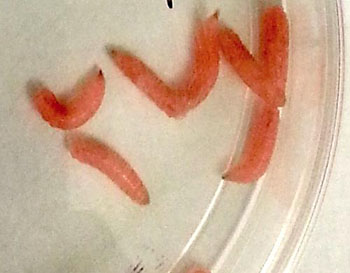Genetically Engineered Maggots Could Augment Wound Healing
By HospiMedica International staff writers
Posted on 03 Apr 2016
A new study describes how maggot debridement therapy (MDT) larvae can be genetically modified to release a human growth factor that actively stimulates cell growth and wound healing.Posted on 03 Apr 2016
Researchers at North Carolina State University (NCSU; Raleigh, USA) and Massey University (Wellington, New Zealand) developed a concept MDT technology that is based on transgenic strains of Lucilia sericata (green bottle fly) larvae that express and secrete human platelet derived growth factor-BB (PDGF-BB) at detectable levels in adult hemolymph, whole larval lysate, and maggot excretions/secretions (ES), with the potential for clinical utility in wound healing.

Image: L. sericata larvae produce and secrete a human growth factor (Photo courtesy of Max Scott/NCSU).
The researchers engineered transgene insertion in several strains of L. sericata, and tried two ways to make the maggots produce and secrete PDGF-BB. First, they engineered maggots that produce the PDGF-BB when they are shocked with heat up to 37 °C; but while heat made the maggots produce the hormone, they did not release it. The other system, which mediated PDGF-BB expression by raising the maggots on a diet that lacked tetracycline, was more successful, resulting in high levels of the growth factor. The study was published on March 22, 2106, in BMC Biotechnology.
“We see this as a proof-of-principle study for the future development of engineered L. sericata strains that express a variety of growth factors and antimicrobial peptides with the long-term aim of developing a cost-effective means for wound treatment that could save people from amputation and other harmful effects of diabetes,” said lead author Professor of Entomology Max Scott, PhD, of NCSU. “Most people with diabetes live in less wealthy countries with little access to expensive treatments, and MDT could offer them an effective and accessible alternative.”
Human PDGF-BB is a secreted dimeric peptide growth factor that stimulates cell proliferation and survival, promotes wound healing, and has been investigated as a possible topical treatment for non-healing wounds. Genetic engineering has allowed for the expression and secretion of human growth factors and other proteins in transgenic insects.
Related Links:
North Carolina State University
Massey University














